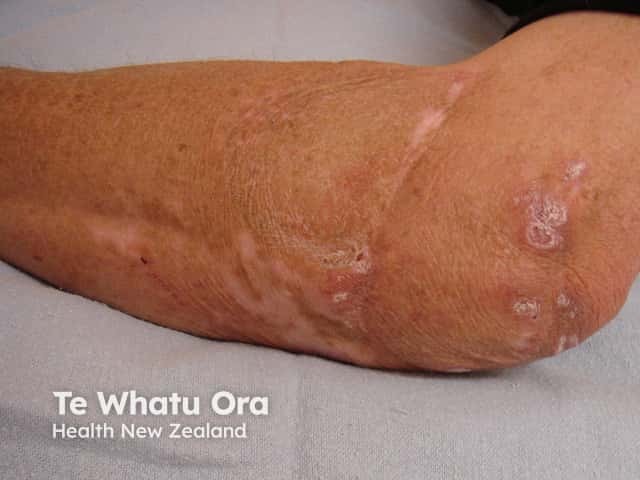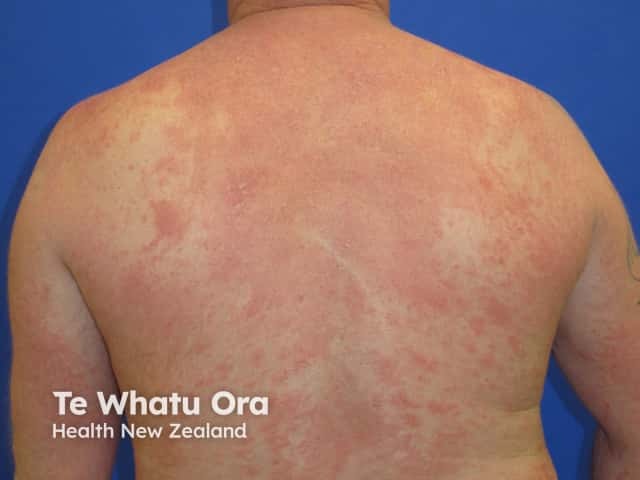Main menu
Common skin conditions

NEWS
Join DermNet PRO
Read more
Quick links
Common variable immunodeficiency — extra information
Common variable immunodeficiency
Author: Brian Wu PhD. MD Candidate, Keck School of Medicine, Los Angeles, USA; Chief Editor: Dr Amanda Oakley, Dermatologist, Hamilton, New Zealand, September 2015.
What is common variable immunodeficiency?
Common variable immunodeficiency is one of the more common forms of primary immunodeficiency disorder and is also called common variable hypogammaglobulinemia. Common variable immunodeficiency leads to immune system impairment and to increased vulnerability to secondary infections.
What causes common variable immunodeficiency?
The exact cause of most cases of common variable immunodeficiency is only incompletely understood. What is known is that:
- Common variable immunodeficiency is associated with mutations in at least ten genes
- Many of these genes are involved with the development and growth of B-lymphocytes
- This results in a lack of immunoglobulin G (IgG) and sometimes also immunoglobulin A or immunoglobulin M (IgA or IgM).
- Secondary T cell functional abnormalities and abnormal cytokine production may also occur.
Common variable immunodeficiency is inherited most frequently in an autosomal recessive pattern and, much more rarely, in an autosomal dominant pattern. Family history is absent in 90% of patients.
What are the signs and symptoms of common variable immunodeficiency?
Common signs and symptoms of common variable immunodeficiency include:
- Frequent infections of the respiratory tract, especially otitis media, pneumonia and sinusitis
- Bronchiectasis (lung damage) from recurring pneumonia
- Infection (eg giardia) or inflammation of the gastrointestinal tract with secondary symptoms of diarrhoea and weight loss
- Enlarged lymph nodes and spleen
- Noninfectious granulomas in lungs, lymphoid tissue, liver, spleen and eyes
- Increased cancer risk, particularly lymphoma
- Autoimmune disease in 25%, most often thrombocytopenia, haemolytic anaemia and rheumatoid arthritis
Patients with common variable immunodeficiency cannot be protected from infectious diseases through vaccination since they cannot mount an antibody response.
Cutaneous disease
Common variable immunodeficiency may cause skin disease. The most common cutaneous manifestations of common variable immunodeficiency are:
- Bacterial skin infections, such as impetigo, cellulitis and boils
- Autoimmune diseases, such as vitiligo, alopecia areata, psoriasis, systemic lupus erythematosus and vasculitis
- Autoinflammatory disease: pyoderma gangrenosum
- Necrotising and non-necrotising granulomas: papules, plaques, nodules and ulcers
- Maculopapular rash
- Purpura due to thrombocytopenia

Granulomas in a patient with common variable immunodeficiency

Granulomas in a patient with common variable immunodeficiency
How is common variable immunodeficiency diagnosed?
Common variable immunodeficiency may be suspected in a patient presenting with a history of recurrent respiratory infections. The diagnosis is confirmed by measuring B-cell counts and immunoglobulin levels.
Skin lesions often require biopsy for precise diagnosis. Granulomas often resemble granuloma annulare or sarcoidosis histologically, although they are clinically distinctive.
What is the treatment for common variable immunodeficiency?
Antibiotics
Antibiotics are used to treat secondary bacterial infections.
Immunoglobulin replacement therapy
Common variable immunodeficiency is generally treated by immunoglobulin replacement therapy administered by slow intravenous injection (monthly), intramuscularly or subcutaneously (weekly). Brands available in New Zealand are listed here. They are made from human plasma.
- Intragam® P (IV)
- Flebogamma® (IV)
- Privigen® (IV)
- Normal Immunoglobulin-VF (IM)
- Evogam® (SC)
Adverse reactions have been estimated to occur within 6 hours in 2–25% of immunoglobulin infusions and are usually mild. They include malaise, headache, fever, urticaria, itch, nausea, abdominal pain, hypertension and hypotension. Headache may persist for several days after infusion. Rare severe reactions are reported to include tightening of the throat, anaphylaxis and seizures.
Persistent pain, bruising, swelling and erythema may occur at the site of subcutaneous immunoglobulin.
Delayed systemic adverse reactions are uncommon but may be serious.
- Aseptic meningitis
- Renal failure
- Thromboembolism
- Haemolytic anaemia
- Lung disease
- Enteritis
- Dermatitis, morbilliform, lichenoid and other rashes
- Infection

Lichenoid reaction

Dermatitis
Other treatments
Patients with granulomas and autoimmune reactions may be treated with immunosuppressive agents (corticosteroids, ciclosporin, cyclophosphamide) and anti-TNFα biologic agents.
References
- Common variable immunodeficiency. American Academy of Allergies, Asthma and Immunology.
- Common variable immunodeficiency. Genetic Home Reference. National Institute of Health. 2014.
- Definition: common variable immunodeficiency. Mayo Clinic. 2015.
- Swartz, R. Common variable immunodeficiency. Medscape. 2015
- Agarwal S, Cunningham-Rundles C. Autoimmunity in Common Variable Immunodeficiency. Current allergy and asthma reports. 2009;9(5):347-352.
On DermNet
- Immunodeficiency
- Immunoglobulin replacement therapy
- Severe combined immunodeficiency
- Specific IgA deficiency
- IgG subclass deficiency and specific antibody deficiency
Other websites
- Immune Deficiencies Foundation of Australia (IDFA)
- Immune Deficiencies Foundation of New Zealand (IDFNZ)
- Immune deficiencies — Australasian Society of Clinical Immunology and Allergy (ASCIA)
